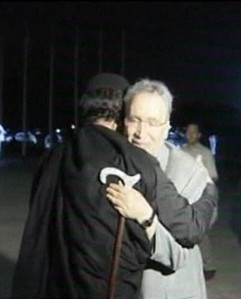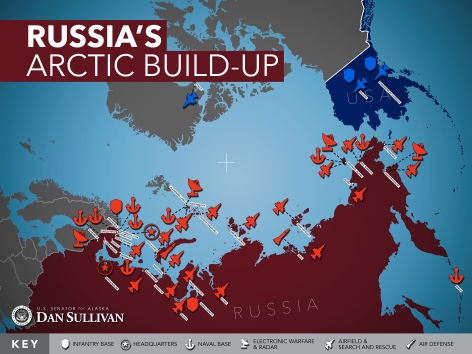> – Russian Navy Eats Humble Pie to Accelerate Modernization and Expansion: Buys French-Built Amphibious Assault Ship, Negotiates Production of More Such Vessels
– Russian Navy Eats Humble Pie to Accelerate Modernization and Expansion: Buys French-Built Amphibious Assault Ship, Negotiates Production of More Such Vessels
– Russian Military Analyst Assesses Above Purchase, Speculates Moscow Possibly Preparing to Reinvade Ukraine, Georgia, and Baltics
– Eastern European “Cyber-Gangs” Target Small, Medium-Sized US Businesses, Electronically Rob and Transfer Funds within Minutes
– Lyricist Who Wrote Russia’s Soviet and “Post”-Communist National Anthems Dies, Praised by Stalin, Putin, Medvedev
The MSM reported on August 27 that Russia has deployed its most advanced anti-missile system close to its short border with the Democratic People’s Republic of Korea. Russia’s Chief of the General Staff, Nikolai Makarov, informed reporters on a trip with President Dmitry Medvedev to Mongolia that the military’s third operational S-400 anti-missile division was tasked with shooting down ballistic missiles that could conceivably stray over Russian territory from North Korea. On the surface this story has some plausibility as the Russian naval port of Vladivostok is only 93 miles from North Korea. In 2006 an off-course North Korean missile reportedly plunged into Russian waters near the port of Nakhoda. Incidentally, nearly 90 years after the reds seized Mongolia, that country’s “ex”-communists continue to hold the reins of government in Ulan Bator.
“We are definitely concerned by the conditions under which tests are being carried out in North Korea, including nuclear devices,” Makarov fretted. One analyst, though, described the general’s comments as “baffling.” Mikhail Barabanov, a Moscow-based defense analyst insisted that there was no evidence that Russia had deployed its S-400 Triumf system in the Far East. “Either the general was doing some sort of PR, or the journalists didn’t understand what he was talking about,” Barabanov pondered. However, he conceded that the military may have transferred the radio-location system for the S-400 to the North Korean border to monitor missile tests.
“Makarov’s remarks,” editorializes The Guardian, “indicate that Russia apparently shares the US’s assessment of North Korea’s nuclear threat, after the north’s nuclear test in May and a series of launches of small- and medium-size missiles, which provoked international condemnation.” The Iranian media, uncritically citing Russia Today, quoted Makarov as saying: “We have deployed an S-400 battalion [in the Far East] already. We are taking preventative measures to secure ourselves from misfired missiles and to make absolutely sure their debris does not fall on Russian territory.” The other two S-400 divisions are stationed around Moscow and in southern Russia, the country’s industrial heartland, sometimes known as the “Red Belt” due to its reliable popular support for the Communist Party.
A more credible explanation for the reported deployment of Russia’s third S-400 division is to counter the still-growing US National Missile Defense system, which includes interceptor missiles at Fort Greely, Alaska and Vanderbilt Air Force Base, California. It may be, too, that the neo-Soviet leadership is still nervous about the Pentagon’s apparent interest in setting up anti-missile batteries around the periphery of the “post”-Soviet space. Although Moscow has dissuaded the Obama White House from carrying out former US President George W. Bush’s plans of deploying interceptor missiles in “post”-communist Poland and a radar base in the “post”-communist Czech Republic, the Department of Defense is now eyeing NATO member Turkey and EU ally Israel as possible sites for interceptor missiles.
“The Kremlin, however,” rightly observes the UPI news agency, “says the planned location in Eastern Europe is compromising Russia’s national security and a further sign of NATO’s eastward expansion. Russia believes the alliance has turned from a security coalition into a geopolitical tool used by the United States to increase its political and economic clout in Eastern Europe.”
Turkey, which moved into Russia’s orbit following last year’s Caucasian War, may not be receptive to that idea of hosting elements of Washington’s NMD. Israel, which armed and trained the Georgian army, much to the Kremlin’s displeasure, already hosts a mobile US radar system in the Negev Desert, ostensibly to track Iranian ballistic missile launches. Russia and Iran, of course, are close allies, while Tehran has submitted an application for full membership in the Moscow-Beijing-led Shanghai Cooperation Organization.
The above story was first reported by the Polish daily Gazeta Wyborcza but the US embassy in Ankara, according to the Turkish media, denies that any such negotiations to place US interceptor missiles in Turkey are underway. During the (first) Cold War, Turkey, then a reliable bastion of anti-communism, also hosted US ballistic missiles that were trained on Soviet targets.
 Meanwhile, the Kremlin, which has re-projected a limited naval influence throughout the world over the last two years, acknowledges that its navy is sorely in need of accelerated modernization and expansion in the face of a deficient military-industrial establishment. To that end, Moscow, tapping its oil and natural gas revenue, intends to buy a helicopter-carrying Mistral-class amphibious assault ship, equipped with hovercraft and landing craft, from NATO member France. The agreement for purchase will be completed by the end of 2009, revealed General Makarov, who refused to name a price. Earlier this month, though, the Russian government daily Rossiiskaya Gazeta reported that the assault ship, which can carry 16 heavy helicopters, 470 airborne troops and other gear, costs 700 million euros (US$995 million). The 200-metre (656-foot) assault ship is equipped with high-tech communications equipment and is designed to control a NATO amphibious operation.
Meanwhile, the Kremlin, which has re-projected a limited naval influence throughout the world over the last two years, acknowledges that its navy is sorely in need of accelerated modernization and expansion in the face of a deficient military-industrial establishment. To that end, Moscow, tapping its oil and natural gas revenue, intends to buy a helicopter-carrying Mistral-class amphibious assault ship, equipped with hovercraft and landing craft, from NATO member France. The agreement for purchase will be completed by the end of 2009, revealed General Makarov, who refused to name a price. Earlier this month, though, the Russian government daily Rossiiskaya Gazeta reported that the assault ship, which can carry 16 heavy helicopters, 470 airborne troops and other gear, costs 700 million euros (US$995 million). The 200-metre (656-foot) assault ship is equipped with high-tech communications equipment and is designed to control a NATO amphibious operation.
Tellingly, Makarov admitted that Moscow intends to forge a deal with Paris on joint production of more such ships. “We also want to establish production of a series of at least four or five ships of this class. No country in the world can do everything on its own,” he conceded, no doubt swallowing some neo-Soviet pride as he did so, “Some things will have to be purchased from foreign producers.”
That the Soviets are purchasing military equipment from NATO to upgrade their own forces is not surprising in view of the fact that Moscow has sold combat helicopters, tanks, and armored personnel carriers to NATO countries such as Turkey and Greece. However, such treasonous familiarity simply exposes the fact that the NATO leadership not only does not recognize the Soviet strategic deception but also is compromised at the highest organizational levels. Indeed, KGB-trained Hungarian spy master Sandor Laborc assumed NATO’s rotating top intelligence post in 2008. In both the czarist era and later in the Soviet era, through Washington’s ill-conceived Lend-Lease Program, coordinated by documented Soviet agent Harry Hopkins, Russia routinely made substantial weapons purchases from suppliers in the West.
“This is the first major step in that direction—of Russia turning to the West to modernise its military and military industry,” observed Russian military analyst Pavel Felgenhauer, “It is a major change. We’re talking not just about buying off the shelf but also getting the technology. There is going to be discussion about this. The ship purchase and production agreements with France will likely come under scrutiny from Washington as naval ships built in France and other NATO states contain potentially sensitive US technologies.” Felgenhauer speculated that the Russian Navy could use its French-built amphibious assault ships to land special forces along the coast of “former” Soviet republics like Ukraine, Georgia, and the Baltic states.
On August 26, in what could be a case of disinformation, possibly like the story about the S-400 deployment in Far East Russia, General Makarov announced that production of the troubled Bulava submarine-launched ballistic missile (SLBM) has been moved to an alternative factory due to “problems in the production cycle.” According to the Nezavisimaya Gazeta newspaper, Russian military and defense industry experts were taken aback by Makarov’s statement since there is only one plant in Russia—Votkinsky Zavod in the Ural Mountains—that manufactures solid-fuel ballistic missiles for the Strategic Missile Forces, including the Topol-M, Iskander-M, and Bulava-30.
“Apparently, the media misinterpreted what Gen. Makarov said because there is nowhere to transfer Bulava production to from the Votkinsky plant,” commented former chief of staff of the Strategic Missile Forces, Colonel General Viktor Yesin. He added: “On the other hand, it is possible to change manufacturers of faulty components supplied to the plant. Here we have some options, but the choice is still limited.”
The Bulava, which is being developed by the Moscow Institute of Thermal Technology, has suffered six failures in 11 tests. The SLBM carries up to 10 MIRV warheads and has an estimated range of over 8,000 kilometers (5,000 miles). The three-stage missile will be deployed on new Borey-class nuclear-powered strategic submarines. Russia’s top brass expects the Bulava, along with Topol-M land-based ballistic missiles, to become the core of Russia’s nuclear triad.
A likely precursor of the Communist Bloc assault against the West will be a pre-“Missile Day” cyberattack against military and civilian infrastructure computer networks in the West. Peace-time probes have already taken place, instigated by security agencies, military sabotage divisions, and state-sponsored criminal groups in Russia, Eastern Europe, China, and North Korea. Russian hackers also purportedly disrupted websites in Estonia in 2007, in connection with the international dispute over a Soviet war monument in the capital Tallinn, and Georgia in 2008, in advance of the neo-Soviet occupation of Abkhazia and South Ossetia.
Along this theme, on August 25 the Washington Post reported that criminal “cyber-gangs” in Eastern Europe are targeting small and medium-sized companies in the USA. These invisible cyber-gangs electronically transfer money from bank accounts via “money mules,” who are willing or unwitting individuals involved in the fraud. Sometimes these illegal transactions are conducted within half an hour, before the account holder realizes that he has been robbed. “Eastern European organized crime groups are believed to be predominantly responsible for the activities that are employing witting and unwitting accomplices in the U.S. to receive cash and forward payments — from thousands to millions of dollars to overseas locations — via popular money and wire transfer services,” warns an alert from the Financial Services Information Sharing and Analysis Center. The reader should be reminded that the deliberate disruption and demise of the capitalist economies, which are already experiencing serious convulsions, is a key objective of the communist conspiracy.
Finally, in a related story that will no doubt enflames the hearts of many Russians with neo-Soviet pride, children’s writer and poet Sergei Mikhalkov, who penned the lyrics to the Soviet and “post”-communist Russian national anthems, died on August 27 at the ripe old age of 96. President Medvedev, a Soviet Komsomol graduate, expressed condolences to the poet’s widow, sons, and other family members. Mikhalkov died in a Moscow hospital.
In 1943 Soviet dictator Joseph Stalin commissioned a new national anthem, with the lyrics to be written by Mikhalkov and music composed by Alexander Alexandrov. As a result of his contribution to the Soviet cause, Mikhalkov received a series of major awards, including the highly prestigious Stalin prizes. In the 1970s he altered the lyrics to delete reference to Stalin. After the Soviet Union was dismantled in 1991, the anthem was briefly abolished by President Boris Yeltsin but restored under his hand-picked successor, Vladimir Putin. Yet another version of the national anthem was officially adopted in 2001, after Mikhalkov was picked once again to rewrite the lyrics to Alexandrov’s music. Two years later Putin visited Mikhalkov at his home, decorating the lyricist with the Order for Service to the Fatherland and recognizing his contributions to Russian culture.
In conclusion, we see through the venerable Mikhalkov’s close relationship with both Stalin and Putin perfect harmony between the paleo-Soviet and neo-Soviet leaderships.







